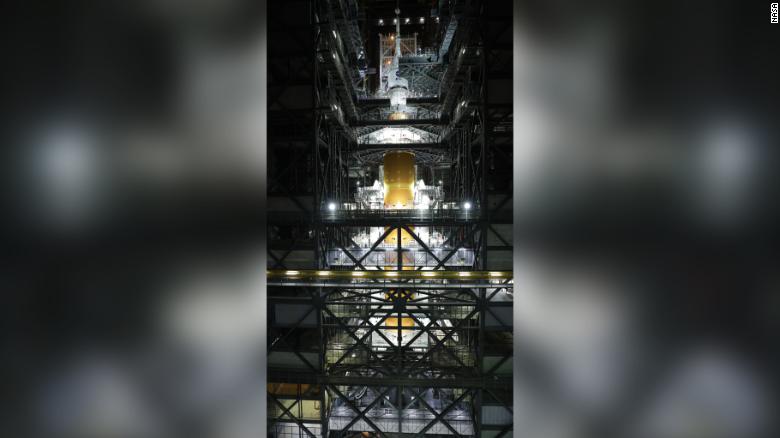They will take a person of color to the Moon for the first time 0:36
(CNN) -
The launch of Artemis I, an unmanned mission that marks the first step in NASA's ambitious program to put humans back on the Moon, will be delayed until at least February, according to the agency.
The launch of the mission was originally scheduled for November, but delays due to the pandemic, storms like Hurricane Ida and other factors have lengthened the mission schedule.
To the Moon and Beyond: How is Artemis, the NASA program that aims to take us back to Earth's natural satellite in 2024, going?
During the flight, the unmanned Orion spacecraft will launch on top of the SLS rocket to reach the Moon and travel thousands of kilometers beyond it, more than any spacecraft intended to transport humans has ever traveled.
This mission is expected to last a few weeks and end with Orion's splashdown in the Pacific Ocean.
The agency completed the assembly, or fixing of the Orion spacecraft on top of the giant rocket Space Launch System (SLS) just before midnight Thursday at NASA's Kennedy Space Center in Florida.
The Orion spacecraft is shown stacked atop the SLS rocket at the Kennedy Space Center on October 21.
"With the completed assembly and integration of the NASA Space Launch System rocket and the Orion spacecraft, we are ever closer to embarking on a new era of human deep space exploration," said NASA Administrator Bill Nelson in a statement.
"Thanks to the team's hard work designing, manufacturing, testing and now completing the assembly of NASA's new rocket and spacecraft, we are in the final stretch of preparations for the first launch of the Artemis I mission, paving the way for explore the Moon, Mars and beyond for many years. "
The mobile platform, which stands 98 meters high inside the Vehicle Assembly Building, is ready to enter the final phase of testing ahead of a launch window that opens on February 12 and closes on February 27.
advertising
This last stage will include integration tests between Orion and the rocket before the mobile platform is brought to the launch pad.
The platform will then undergo the final test, called "wet dress rehearsal" or general fuel test, which includes the execution of all the propellant loading operations in the fuel tanks and a launch countdown: basically, everything you need for a launch without actually doing it.
If this test, scheduled for January, is successful, the platform will return to the Vehicle Assembly Building until it is ready for the actual launch.
Following the unmanned flight of Artemis I, Artemis II will be a manned mission that will fly over the Moon and Artemis III will take astronauts to the lunar surface, taking there for the first time a woman and a person of color.
The release schedule for the following missions is up to Artemis I.
Artemis, a small step for women: can NASA excite this generation to return to the Moon?
"It's taller than the Statue of Liberty, and I like to think of it as the Statue of Liberty, because it's a very complicated team, and it's very inclusive, it represents everyone," said Tom Whitmeyer, deputy administrator for exploration systems development at NASA, in a press call on Friday.
"The rocket itself was built with people from every state in the United States of America. And it is a very important achievement for this country."
While completing assembly is a key milestone in the mission's home stretch, there are other challenging priorities ahead, Mike Sarafin, head of the Artemis I mission at NASA Headquarters, said during the press conference.
Tests such as the wet dress rehearsal are designed to ensure that Artemis I is fully prepared.
The test results could change the release date.
"We have purposely prepared a stress test for our Space Launch System rocket and our Orion spacecraft," Sarafin said.
"Our four main goals are to demonstrate Orion's ability to return from the Moon under lunar reentry conditions, operate our flight systems in the flight environment, recover our spacecraft, and then what I like to call extra targets."
These additional lenses include the "remarkable photos" that will be captured by the wingtip cameras mounted on the wingtips of the Orion solar array during its journey between the Earth and the Moon, as it is circling the moon, and as it returns. home and splash.
"Orion will take selfies of himself, and we will see the moon in the background and us in the distance," Sarafin said.
"We are going to see Earth from some 434,522 kilometers away, and we will really get a new perspective for the Artemis generation."
NASA's Lucy mission took off to explore never-before-seen asteroids
Ultimately, the launch date will determine the length of the mission.
During the 15-day launch period in February, half of the days could result in a long-class mission, lasting six weeks, while the other days would mean a short-class mission lasting about four weeks.
If the launch does not occur in February, there are also opportunities for Artemis I to take off from the platform between March 12-27 and April 8-23.
Artemis I will be Orion's last proving ground before the spacecraft takes astronauts to the moon, a thousand times farther from Earth than the space station, said Cathy Koerner, director of the Orion program at the Johnson Space Center of the United States. NASA, during the press conference.
"It will really demonstrate the capabilities of our spacecraft, and in more extreme radiation environments," he said.
"We look forward to sending Orion to the Moon and seeing its performance in that environment."
ArtemisNASA

